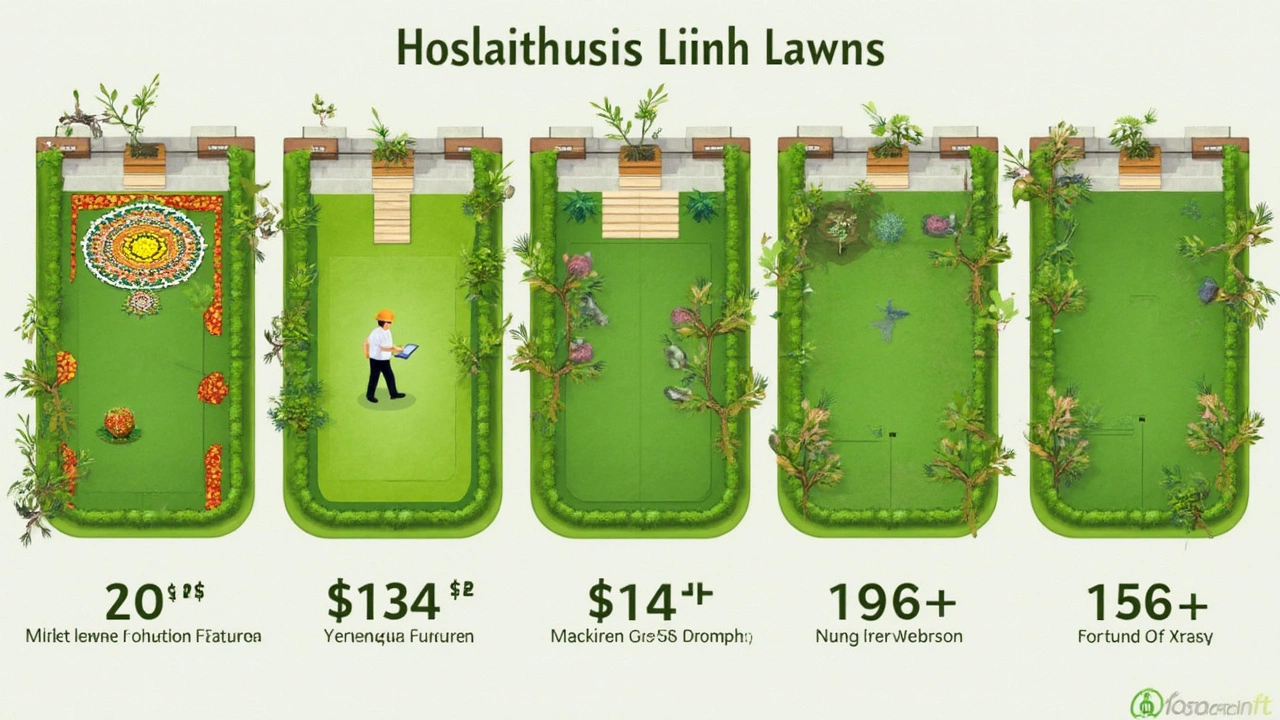Ever wondered if you're paying too much for your weekly mow? You’re not alone. Lawn mowing isn’t a one-price-fits-all deal—what your neighbor pays could be totally different from what you pay. That’s because prices bounce around depending on the size of your yard, where you live, and even how tall the grass is when the crew shows up.
If you live in a small suburb, you might pay anywhere from $30 to $60 for a standard mow. Got a big backyard that’s been ignored for a month? Don’t be surprised if the price doubles. Most folks nationwide end up paying about $45 per visit for a typical quarter-acre lot. Now, if you throw in extras like edging, blowing clippings off the sidewalk, or bagging up the grass, that bill can creep up another $10 or $20 quick.
It pays to know these numbers—and exactly what’s included—before you let someone loose on your yard. A lot of people get surprised by hidden fees or find out they’re being charged way more than average. Knowing what most people really pay makes it way easier to spot a fair deal.
- What’s the average cost to mow a lawn?
- Pricing factors that change the game
- Extra charges you might not expect
- How to save money on lawn service
- Spotting red flags with cheap mowing deals
What’s the average cost to mow a lawn?
If you’re trying to figure out a normal price for cutting your grass, you’re not alone. In 2025, most people are paying between $35 and $70 for each lawn mowing visit. That range might look big, but it comes down to where you live and how big your yard is. For a typical quarter-acre yard—which is about the size of most suburban lots—the sweet spot is close to $45 per mow right now.
Price jumps quickly if your yard is much bigger, has tricky hills, or hasn’t been touched in a while. It’s not just about a flat rate. Some companies charge by the square foot, but most just look at the overall size and how much work it’ll take. In cities, lawn mowing can cost a bit more, mostly because everything’s more expensive and gas isn’t getting any cheaper. If you live in a smaller town or a less busy area, rates can be on the lower end.
According to HomeAdvisor, “The typical cost to mow a lawn in the U.S. is $35 to $70 per cut, depending on yard size and local prices.”
Here’s a quick look at average costs by yard size so you can size your own up:
- Small yards (under 1/8 acre): $25-$40 per mow
- Medium yards (1/8 to 1/4 acre): $35-$50 per mow
- Large yards (up to 1/2 acre): $45-$70 per mow
- Very large properties (1 acre or more): $75 and up, sometimes well over $100
If you see a price that seems way higher (or a lot lower) than these, it’s worth asking why. Sometimes super low rates mean a quick mow with no cleanup, while higher prices might include extras or cover tough terrain. If you want to keep tabs on your lawn mowing cost, make sure you compare what’s actually included in each quote. Never hurts to ask for a breakdown, either.
Pricing factors that change the game
Your buddy down the street might brag about his $25 mow, but a bunch of things are hiding behind every quote. Knowing what affects lawn mowing cost can help you figure out if you’re getting a deal or if someone’s trying to squeeze a few extra bucks out of you.
Here’s what really makes the price swing:
- Lawn Size: Bigger yards simply take more time and eat up more gas. Most companies bump up their standard price for every extra 1,000 square feet. A tiny city yard could cost $30, but if you've got half an acre, it might land at $70 or higher.
- Grass Height and Condition: If your lawn looks like a jungle, expect a “tall grass fee.” Overgrown yards are tougher on the mower and usually slow the crew way down.
- Frequency: Weekly service nearly always costs less per mow than a once-a-month rescue mission. It’s like a volume discount—more regular jobs, lower price per visit.
- Location: Folks in big cities usually pay more. Places with a higher cost of living like California or New York see mows at the top of the price range, while small towns in the Midwest often run cheaper.
- Obstacles and Shape: Got a fenced yard, steep slopes, tons of trees, or flower beds everywhere? Expect to pay extra for all that maneuvering.
To see just how much these factors matter, check out how much average prices swing by location and yard size:
| Region | Small Yard | Medium Yard | Large Yard |
|---|---|---|---|
| Midwest | $30 | $45 | $60 |
| South | $35 | $50 | $65 |
| West Coast | $40 | $60 | $80 |
| Northeast | $45 | $65 | $85 |
Another thing—whether you want to pay a company with insurance or the teen next door makes a huge difference. Companies are more expensive, but you’re covered if something goes wrong. Some folks pay more for the peace of mind.

Extra charges you might not expect
Here’s where that simple yard job can get sneaky. Lawn services love to keep things basic in their ads, but lots of the real work isn't included in that first price. That’s how the bill goes from $45 to $80 when you weren’t looking. If you're not clear on what’s covered, you could be surprised by all sorts of extra fees.
Some of the most common add-ons and upcharges include:
- Edging and trimming: The initial price is often just for mowing, but making those sharp lines along your driveway, walkways, or flower beds usually tacks on another $10–$20.
- Bagging and hauling clippings: Most basic mow jobs leave clippings on the lawn, which is fine for many folks. But if you want those clippings bagged up or even hauled away, expect to pay another $5–$15, sometimes even more for bigger yards.
- Tall or overgrown grass: If your grass is over six inches high, most companies consider that 'overgrown.' They’ll often charge 50% more, or even double the base rate, especially if mower blades get bogged down or they need to do a double pass.
- Obstacles or tough terrain: Got a steep hill, a ton of garden beds, or a dog run? These make the job slower and bump up the price, usually by $10–$25, depending on just how fussy your yard is.
- Last-minute or single visits: Want someone once, not on a schedule? One-off mows usually cost $5–$10 more per visit because companies prefer regular customers.
Don't forget about add-on services like weed removal, fertilizing, or pest control. These aren’t covered in the typical lawn mowing cost—they’ve got their separate price tags. It’s easy to get talked into a “full-service” deal that’s suddenly hundreds of bucks more than you planned.
So, before you hire, always double-check what’s included. Ask for a breakdown in writing. That way, you know exactly what you’re getting and where every dollar goes.
How to save money on lawn service
If you’re tired of watching lawn care eat up your monthly cash, you’re not stuck. There’s actually a bunch of tricks people use to keep their yard looking sharp without blowing the budget. The biggest thing? Shop around. Don’t just grab the first flyer in your mailbox or go with whoever your neighbor uses out of habit.
- lawn mowing cost comparison is a smart move—get two or three quotes and see if they actually match up with the average in your area. Sometimes prices swing as much as $20 per cut between two local companies, even for the same size yard.
- Try booking a seasonal package deal instead of paying per mow. Most companies take a chunk off the total if you commit to the whole summer. For example, someone who locks in for 20 weeks might save $100 or more compared to paying one time at a shot.
- If you handle the easy stuff—like picking up sticks, mowing more often, or skipping extras like bagging—you’ll usually get a cheaper rate. Crews work faster when there’s less junk in the way, and regularly trimmed grass is a breeze compared to jungle-level lawns.
- Consider pairing up with neighbors for a group discount. A lot of local services will charge everyone less if they can do two or three lawns in one stop without pulling their trailer all over town.
- Ask about new customer deals. It’s not rare for first-timers to get a discounted rate for the first month or a free mow if you sign a contract, especially in the busy season when companies want to lock you in.
To give you an idea how much these moves can save, check out this quick data table from a recent survey of U.S. lawn care customers in 2024:
| Money-Saving Move | Average Savings Per Year |
|---|---|
| Comparing 3+ quotes before hiring | $120 |
| Seasonal package deal | $80 |
| DIY prep (yard clean-up/task reduction) | $60 |
| Neighbor group discount | $70 |
| First-time customer special | $30 |
Bottom line? Stack a few of these tricks and you might save a couple hundred bucks a year. That’s enough for a new grill, pool passes for the kids, or even just some decent takeout instead of grass clippings all over your shoes.

Spotting red flags with cheap mowing deals
Too-good-to-be-true prices for lawn mowing are everywhere, especially online or in random flyers. Some deals look amazing—like $15 for a full mow—until you realize what’s missing or what shows up on your bill later. Super low prices can sometimes mean the person is uninsured, unlicensed, or planning to skip important steps. Sometimes you’ll get someone rushing through the job, or worse, just taking your deposit and disappearing.
If you see bargain mowing rates, check for these warning signs:
- No written estimate or contract. If a company won’t give you an honest, written price, they could easily add surprise fees later.
- No business license or insurance. If someone gets hurt, you might be on the hook—playing it safe matters.
- Refusal to list what’s included. Some operators only do the bare minimum, so mowing might mean just driving across your grass, skipping trimming, edging, or cleanup.
- Asking for big cash deposits up front. Most reputable crews might take a small booking fee, but they don’t want full payment before they ever start.
- Bad or no reviews. Reputable pros are proud of their good rep and happy to point you at real reviews.
Check out this warning from the National Association of Landscape Professionals:
"Low prices might seem like a bargain at first, but they often lead to more headaches and extra costs down the line. Qualified companies insure employees, maintain safe equipment, and follow local laws—those extra steps protect homeowners too."
Here’s a quick chart showing what often gets left out with those ultra-cheap mowing ads versus standard service. This helps explain why the lowest price isn’t always the best deal:
| Service | Ultra-Cheap Mowing | Standard Service |
|---|---|---|
| Grass Cutting | Usually covered | Always included |
| Trimming/Edging | Sometimes skipped | Included |
| Blowing Clippings | No or extra fee | Included |
| Debris Cleanup | Rarely included | Included |
| Insured Workers | No | Yes |
When comparing lawn mowing cost, don’t just chase the lowest number. Ask exactly what you’re paying for. If it sounds too cheap, ask yourself what corners are being cut—or if you’ll end up cleaning things up yourself or paying more to fix damage later.
